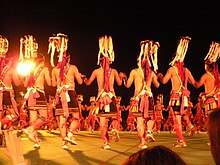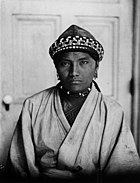|
Amis people
The Amis (Amis: Amis, Ami, Pangcah; Paiwan: Muqami), also known as the Pangcah (which means 'people' and 'kinsmen'), are an indigenous Austronesian ethnic group native to Taiwan. They speak the Amis language (Caciyaw no Pangcah; Minuqamian), an Austronesian language, and are one of the sixteen officially recognized Taiwanese indigenous peoples. The traditional territory of the Amis includes the long, narrow valley between the Central Mountains and the Coastal Mountains (Huadong Valley), the Pacific coastal plain eastern to the Coastal Mountains and the Hengchun Peninsula. In 2014, the Amis numbered 200,604.[1] This was approximately 37.1% of Taiwan's total indigenous population, making them the largest indigenous group.[2] The Amis are primarily fishermen due to their coastal location. They traditionally had a matrilineal kinship system, by which inheritance and property pass through the maternal line, and children are considered born to the mother's people.[3] Traditional Amis villages were relatively large for Taiwanese indigenous communities, typically holding between 500 and 1,000 people. In today's Taiwan, the Amis also comprise the majority of "urban indigenous people" and have developed many urban communities all around the island. In recent decades, Amis have also married exogamously to the Han as well as other indigenous peoples.[4] Identity and classification The Amis people refer to themselves by two different ethnonyms. While those living in the East Rift Valley and Hualien County generally identify as Pangcah, which means "human" or "people of our kind," Amis living in coastal Taitung County employ the term Amis. Perhaps because of the official name, in 21st-century Taiwan, the term Amis is much more frequently used. This name comes from the word 'amis, meaning "north." There is still no consensus in the academic circle as to how "'Amis" came to be used to address the Pangcah. It may originally have been a term used by the Puyuma to refer to the Pangcah, who lived to the north of them. Another theory is that those who lived in the Taitung Plain called themselves "'Amis" because their ancestors had come from the north. This later explanation is recorded in the Banzoku Chōsa Hōkokusho,[5] indicating this term may have originated from a group classified by anthropologists as Falangaw Amis, the Amis group occupying territory from today's Chengkung to the Taitung Plain. Their closest genetic relatives appear to be the native Filipino people.[6][7] According to Taiwanese Aboriginal History: Amis, the Amis are classified into five groups:
Such classification, however widely accepted, is based simply on the geographical distribution and ethnic migration. It does not correspond to observed differences in culture, language, and physiques. The People's Republic of China (PRC), which claims Taiwan as part of its own territory, considers all of the Amis as part of a Gaoshan ethnic group, one of the 56 ethnic groups of the PRC. GeneticsA genetic study showed that Austronesian speakers such as the Ami and Atayal of Taiwan, and Kankanaey of Philippines have significant ancestry (67% to 74%) related to Neolithic Fujian source. That Neolithic Fujian source is also estimated to contribute between 35% and 40% of Han Chinese ancestry in Guangdong and Fujian.[8] CultureTraditions Family affairs, including finance of the family, are decided by the female householder, in the Amis tradition. The most important traditional ceremony is the Harvest Festival. The Amis Harvest Festival is held to express the people's thanks and appreciation to the gods, and to pray for harvest in the next coming year. It takes place every July to September.[9] ClothingTraditional Amis clothes were made with cloth knitted with bark and banana threads with bamboo needles, and used wear-resistant linens and pelts. This evolved during the 20th Century with the arrival of cotton, acquired by the Amis through barter, which progressively phased out the use of traditional material in favor of cotton. There are two clothing styles: Hualien and Taitung. Both use a head scarf, chest covering and a skirt. Chiefs and priests, on the other hand, wear robes and rattan headgear, to distinguish themselves. They also have an ‘alufo’ (“lover’s bag”), made with betel nut by their mother or their lover, which is both used in everyday life and during rituals. It is traditionally used to carry betel nut, limestone, betel and smoking pipes. Traditionally black, Amis clothing has evolved during the 20th century to using more and more red, “for its perceived festiveness and compatibility with ethno-tourism”.[10] The coloring of necklaces distinguishes different Amis communities. Floral headdresses are also often used during special occasions, such as the harvest. Representation in mediaThe musical project Enigma used an Amis chant in their song "Return to Innocence", on their second album, The Cross of Changes (1993). This song was used as the theme song of the 1996 Atlanta Olympics. The main chorus was sung by Difang and Igay Duana, who were part of a Taiwanese aboriginal cultural performance group. Maison des Cultures du Monde had earlier recorded the singing of this group while on tour, and released a CD. This song was subsequently used by Enigma (although they did not note the ethnic origin of the song and the singers). The recording studio and the Taiwanese group filed a suit for copyright infringement, which was later settled by Enigma out of court. Ami singing is known for its complex contrapuntal polyphony. Notable Amis people 
See alsoReferences
Further reading
External linksWikimedia Commons has media related to Amis people.
|
|||||||||||||||||||||||||||||||

